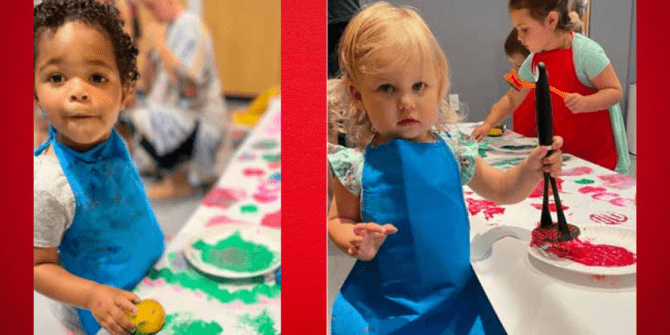
By Ty Papke, Branch Outreach and Programming Specialist
As temperatures drop outside, many of us begin our endless pursuit of indoor activities to keep our children entertained and engaged without plopping them in front of a screen all day. While they may not be as physically active as during the summer months, we can strive to at least keep their minds active by exercising their creativity with arts and crafts.
Fortunately, the internet provides us with infinite craft ideas. Unfortunately, many of these seemingly-simple crafts turn out to be more frustrating for kids than fun. I can’t tell you how many times I’ve been excited to discover the perfect craft – whether for my kids at home or for a library program – only to
find out the kids can’t manage to execute the craft as well as the adult who demonstrated it so gracefully in the video. This becomes even more problematic with a group of children in different stages of development. It will come as no surprise that a five-year-old can wield a pair of scissors with far greater skill than a three-year-old.
It’s natural for children to get frustrated when their hard work doesn’t yield the same result as the example craft, or even the kid next to them. To overcome these challenges, it can help to focus more on the process rather than the product. For this reason, process art has been growing in popularity in recent years.
Process art can take many forms, but always emphasizes the process of creating instead of the final
result. While it may end with a unique piece your child is proud to display, it’s just as likely to end with a sloppy mess that gets tossed in the garbage (an added bonus for those of us who have long since run out of space to display our children’s artwork).
Process art allows children to create in a relaxed setting, without the pressure of making something that’s expected to look a certain way. A variety of mixed media can offer endless possibilities for creation. Your kids can paint with feathers, create a forest out of sticks and play dough, gather all the scrap paper in the junk drawer to make into a sculpture, paint with water on the sidewalk or try making letters in shaving cream on a cookie sheet. Embrace the mess and embrace the process.
However, process art can also be done with something as simple as a pen and paper. A fun and simple activity I do with my youngest daughter requires just two pieces of paper, two writing utensils and a timer (I use my phone). We each begin with a pen and paper. Setting a timer, we each draw for one minute.
When the timer sounds, we swap papers and reset the timer and add on to the other person’s drawing. We continue drawing in one-minute sessions, rotating papers each time, resulting in two silly drawings that combine our creative efforts. To add a literacy element, I ask her to tell a story about each drawing. While this activity has never resulted in a product worth framing, it has produced joy in the process
of creating together.
I encourage all who are interested in exploring process art to search for ideas online. You will be amazed by the hours of entertainment available to your kids with items already in your home or classroom.


Add a comment to: Enjoy the Process